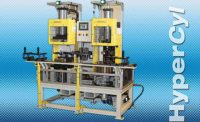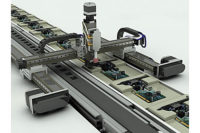The distinction between AC induction motors and permanent-magnet DC servomotors was once fairly clear. AC motors were for high-horsepower applications, such as compressors, pumps, blowers and bulk-handling conveyors. DC servomotors were for applications requiring low horsepower, high torque, high cycling and precise positioning, such as machine tools and pick-and-place machines.
Today, the distinction is less clear. Servomotors are encroaching into high-horsepower applications, while AC motors are increasingly being used in high-performance applications. As the band width and processing power of general-purpose variable frequency drives (VFDs) have increased, AC motors are being employed in applications, such as palletizers and transfer lines, where servomotors have typically dominated, says Mike Rucinski, applications engineering manager with the Drives and Motion Div. of Yaskawa America Inc.
That could be good news for cost-conscious machine designers, since the cost of DC servomotors has spiked in the past five years. AC induction motors are less expensive than servos, and there’s no shortage of suppliers.
VFDs adjust the speed and torque of three-phase AC induction motors by varying the frequency and voltage applied to the stator. A major benefit of VFDs is energy savings. VFDs can be set to reduce power consumption by the motor when the application is running at less than full load. Soft starts are another benefit. VFDs can be programmed to start the motor slowly and smoothly, reducing wear on belts, gears and bearings.
Several new control technologies are enabling AC induction motors to perform more like servomotors. One of them is field-forcing. In an AC motor, a moving electromagnetic field in the stator induces current in conducting bars in the rotor. That current, in turn, generates electromagnetic fields that are attracted to those in the stator, which causes the rotor to turn. As a result, the rotor spins more slowly than the electromagnetic field. That’s known as slip.
Because of its permanent magnets, a servomotor doesn’t have that problem. Torque is instantaneous. Field-forcing is a way to get more rapid torque production with an AC motor. “Upon initial excitation of the motor, the VFD will boost the voltage beyond what it would normally need, in an effort to force current to flow at a faster rate into the motor,” explains Rucinski. “Instead of waiting 100 to 150 milliseconds for magnetizing current to build, field-forcing may be able to reduce that to 50 milliseconds. By forcing the voltage higher, torque-producing current builds more rapidly.”
Another technology for boosting the performance of AC motors is feed-forward control. In a conventional VFD, a proportional integral controller generates a torque reference after calculating velocity error based on feedback from the motor. One problem with that technology is “integral windup.” Following a large change in the set point, the integral term can accumulate an error larger than the maximal speed value. As a result, the system overshoots the target.
With feed-forward control, the VFD uses information about motor and load inertia to generate a torque reference immediately. It’s a little like your household thermostat detecting that you’ve left the door open and turning on the furnace before the house gets too cold.
“Rather than wait on the controller to integrate and generate a torque reference, feed-forward control immediately puts in a step change on the torque reference,” says Rucinski. “That generates rapid torque production without the need for high gain on the controller.”
One more advance in VFD control is known as “zero servo” control. Ordinarily, an AC motor would be stopped simply by de-energizing it. The motor stops producing torque, and some sort of mechanical system, such as a friction brake, is then applied to stop the motor and keep the load in place.
Zero servo control allows the VFD to momentarily stop the motor without de-energizing it. The motor itself acts as a holding brake. Rucinski stresses that this function can only be used for short periods of time. “Even though the motor is not rotating, there’s still current running through it,” he says. “Many AC motors have shaft-mounted cooling fans. If the shaft isn’t turning, there’s no air flowing over the motor, and it could overheat.”




